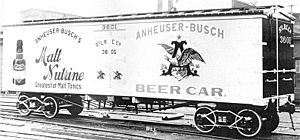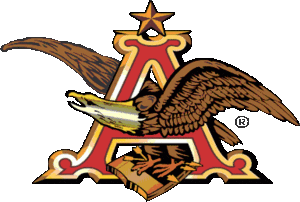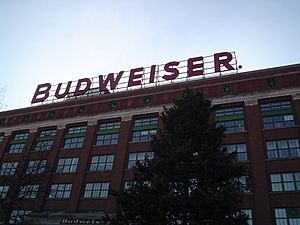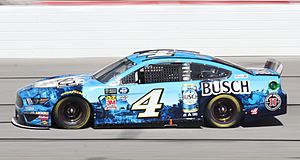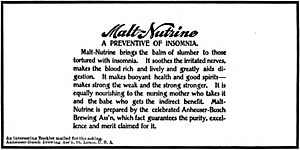Anheuser-Busch facts for kids
 |
|
| Subsidiary | |
| Industry |
|
| Founded | 1852 (as Bavarian Brewery) St. Louis, Missouri, United States |
| Founder | |
| Headquarters |
St. Louis, Missouri
,
U.S.
|
|
Number of locations
|
12 Breweries & 9 Can Plants |
|
Area served
|
North America |
|
Key people
|
|
| Products |
|
| Revenue | US$15.588 billion (2018) |
| US$9.811 billion (2018) | |
| Parent | AB InBev |
Anheuser-Busch Companies, LLC /ˈænhaɪzər ˈbʊʃ/, is an American brewing company headquartered in St. Louis, Missouri. Since 2008, it has been wholly owned by Anheuser-Busch InBev SA/NV (AB InBev), now the world's largest brewing company, which owns multiple global brands, notably Budweiser, Michelob, Stella Artois, and Beck's.
The company employs over 19,000 people, operates 12 breweries and 9 aluminum can plants in the United States, and until December 2009, was one of the largest theme park operators in the United States, with ten theme parks through the company's family entertainment division Busch Entertainment Corporation.
Contents
History
Beginnings and national expansion
In 1852, German American brewer and saloon operator George Schneider opened the Bavarian Brewery on Carondelet Avenue (later known as South Broadway) between Dorcas and Lynch streets in South St. Louis. Schneider's Brewery expanded in 1856 to a new brewhouse near Eighth and Crittenden streets; however, the following year, financial problems forced the sale of the brewery to various owners during the late 1850s. In 1860, the brewery was purchased on the brink of bankruptcy by William D'Oench, a local pharmacist, and Eberhard Anheuser, a prosperous German-born soap manufacturer. D'Oench was the silent partner in the business until 1869 when he sold his half-interest in the company. From 1860 to 1875, the brewery was known as E. Anheuser & Co., and from 1875 to 1879 as the E. Anheuser Company's Brewing Association.
Adolphus Busch, a wholesaler who had immigrated to St. Louis from Germany in 1857, married Eberhard Anheuser's daughter, Lilly, in 1861. Following his service in the American Civil War, Busch began working as a salesman for the Anheuser Brewery. Busch purchased D'Oench's share of the company in 1869, and he assumed the role of company secretary from that time until the death of his father-in-law.
Adolphus Busch was the first American brewer to use pasteurization to keep beer fresh; the first to use mechanical refrigeration and refrigerated railroad cars, which he introduced in 1876; and the first to bottle beer extensively. By 1877, the company owned a fleet of 40 refrigerated railroad cars to transport beer. Expanding the company's distribution range led to increased demand for Anheuser products, and the company substantially expanded its facilities in St. Louis during the 1870s. The expansions led production to increase from 31,500 barrels in 1875 to more than 200,000 in 1881.
To streamline the company's refrigerator car operations and achieve vertical integration, Busch established the St. Louis Refrigerator Car Company in 1878, which was charged with building, selling, and leasing refrigerator cars; by 1883, the company owned 200 cars, and by 1888 it owned 850. To serve these cars and switch them in and out of their St. Louis brewery, Anheuser-Busch founded the Manufacturers Railway Company in 1887. The shortline operated until 2011, when Anheuser-Busch sought to shut down operations.
During the 1870s, Adolphus Busch toured Europe and studied the changes in brewing methods which were taking place at the time, particularly the success of pilsner beer, which included a popular Budweiser beer brewed in Budweis. In 1876, Busch took the already well-known name Budweiser and used it for his new beer, even though his product had no connections to the city of Budweis. His company's ability to transport bottled beer made US Budweiser the first national beer brand in the United States, and it was marketed as a "premium" beer.
The company was renamed Anheuser-Busch Brewing Association in 1879; in 1880, Adolphus Busch became company president upon Anheuser's death. The Busch family fully controlled the company through the generations until Anheuser-Busch's sale to InBev in 2008.
During the 1880s and 1890s, Busch introduced a series of advertisements and marketing giveaways for the company, including bottle openers, calendars, corkscrews, pocketknives, postcards, and prints. Among the most well-known of these giveaways was Custer's Last Fight, a lithograph print of a painting by St. Louis artist Cassilly Adams. As a marketing tactic, Busch distributed thousands of copies of the print to bars in 1896, the same year Anheuser-Busch introduced its new "super-premium" brand, Michelob. Eventually, more than one million copies of the print were produced, and it became "one of the most popular pieces of artwork in American history."
At the turn of the 20th century, Anheuser-Busch continued to expand its production facilities to keep up with demand. In 1905, the company built a new stockhouse in St. Louis, and by 1907 it produced nearly 1.6 million barrels of beer. As demands for the prohibition of alcohol in the United States grew, Anheuser-Busch began producing non-alcoholic and low-alcoholic beverages (known as near beer); the most successful of these was Bevo, a malt beverage introduced in 1908. After the death of Adolphus Busch in 1913, control of the company passed to his son, August Anheuser Busch Sr., who continued to combat the rise of prohibitionists. As part of an effort to improve the respectability of drinking, August Busch built three upscale restaurants in St. Louis during the 1910s: the Stork Inn, the Gretchen Inn (now known as the Feasting Fox), and the Bevo Mill.
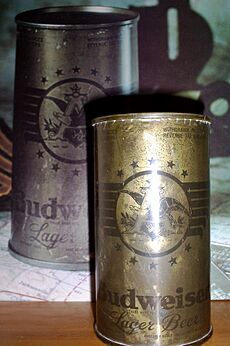
Prohibition period
As with all breweries in the country, the Temperance movement and eventual Prohibition in the United States dealt a major blow to the company in the 1910s through the 1930s. Some of the products sold by Anheuser-Busch to survive during Prohibition included brewer's yeast, malt extract, ice cream, and Bevo, a nonalcoholic malt beverage, or "near beer".
Prohibition to last years of independence
In 1957, Anheuser-Busch became the largest brewer in the United States.
In 1981, Anheuser-Busch International, Inc., was established as a subsidiary responsible for the company's international operations and equity investments. Prior to its 2008 acquisition, Anheuser-Busch operated 15 breweries internationally: 14 in China and one in the United Kingdom.
In 1997, Chinese production of Anheuser-Busch products began after the company's purchase of a local brewery; later, the company operated both Budweiser Wuhan International Brewing Company and Harbin Brewery, which Anheuser-Busch fully acquired in 2004. In the United Kingdom, the Budweiser Stag Brewing Company produced and packaged Budweiser at the Stag Brewery in Mortlake.
At one time, Anheuser-Busch International also held investments in Grupo Modelo in Mexico Tsingtao Brewery in China; Anheuser-Busch also held investments in Redhook Ale Brewery of Seattle, Washington and Widmer Brothers Brewery of Portland, Oregon. After the 2008 acquisition, most international operations were transferred to AB InBev zones where the interests are located.
Acquisition by InBev
On June 12, 2008, Belgian-Brazilian brewing company InBev announced that it had made a US$46 billion offer for the company, which if it was accepted would join two of the world's four largest brewing companies (based on revenue) and create a company brewing three of the highest-grossing beers in the world, namely Bud Light, Budweiser, and Skol. InBev also stated that the merger would not result in any U.S. brewery closures and they would attempt to retain management and board members from both companies. On June 25, 2008, Anheuser-Busch officially announced that they would reject InBev's offer and provide a restructuring of the company to maintain shareholders and United States World Headquarters in St. Louis. On July 1, 2008, InBev urged Anheuser-Busch shareholders to vote in favor of the buyout as InBev felt the offer of $65 per share should be considered a reasonable offer in view of the falling stock market. The company had previously filed suit in Delaware, after the rejection of their offer, to ensure that the stockholders could oust Anheuser-Busch's 13 board members. On July 7, 2008, Anheuser-Busch filed a lawsuit against InBev to stop them from soliciting the support of shareholders, stating that the company's offer is an illegal scheme. InBev was also accused of concealing that they do business in Cuba, which might have created additional obstacles to their efforts to operate in the United States.
On July 13, 2008, Anheuser-Busch and InBev said they had agreed to a deal, pending shareholder and regulatory approval, for InBev to purchase the American icon at $70 per share, creating a new company to be named Anheuser-Busch InBev. Anheuser-Busch would get two seats on the combined board of directors. The all-cash agreement, almost $52 billion in total equity, created the world's largest brewer, uniting the maker of Budweiser and Michelob with the producer of Beck's, Stella Artois, Hoegaarden, Leffe, Bass, Labatt and Brahma. The two companies had combined yearly sales of more than $36.4 billion, surpassing the current No. 1 brewer, London-based SABMiller.
Grupo Modelo took InBev to arbitration for more than a year and a half after the deal was completed, attempting to block the deal.
On October 7, 2009, parent company Anheuser-Busch InBev announced plans to sell the theme parks division to The Blackstone Group for up to US$2.7 billion.
In July 2010, a panel decided that the takeover did not violate Anheuser-Busch's agreement with Modelo.
Post-acquisition changes
On November 18, 2008, the hostile takeover was completed, and the parent corporation was renamed Anheuser-Busch InBev; Anheuser-Busch became a wholly owned subsidiary of the new corporation, controlled within the North America zone unit of AB InBev. By early 2009, AB InBev "turned a family-led company that spared little expense into one that is focused intently on cost-cutting and profit margins, while rethinking the way it sells beer." AB InBev focused on reducing costs in the Anheuser-Busch Companies subsidiary and implemented performance-related pay, along with several other changes. They immediately laid off 1,400 employees and 415 contractors, sold Busch Entertainment Corporation, and sold company-owned aircraft.
For employees, AB InBev ended perquisites such as executive assistants for senior management, company contributions to the salaried employee pension plan, and company-provided life insurance to retirees; it also reduced the number of company-provided cell phones, taking back 1200 Blackberries; and ended tuition reimbursement, and severance packages. Perks like free tickets to St. Louis Cardinals baseball games and for Busch Gardens were taken away from employees. Anheuser-Busch stopped providing free beer to its employees and visitors to its theme parks. These internal changes accompanied changes in its advertising. These cost-cutting measures rapidly reduced AB InBev's debt from $56.6 billion in 2008 to $30.1 billion at the end of 2012. When the restructuring was complete, only three senior-level Anheuser-Busch managers remained.
InBev auctioned off several large assets in an effort to pay off debt to the banks that financed the merger. It sold Anheuser's 27% stake in China's Tsingtao, sold a few beverage can and lid-making plants to Ball Corporation, and sold its own Korean beer business for $1.8 billion to private equity firm Kohlberg Kravis and Roberts & Co. It put the 10 theme parks in Anheuser's Busch Entertainment Unit, which included its three SeaWorld locations, up for sale.
Under InBev, Anheuser-Busch also lengthened accounts payable terms, and introduced zero-based budgeting. These changes caused concern from its suppliers when Anheuser-Busch announced it would take 120 days to pay its bills rather than 30 days, taking time to use that money for other purposes. The new payment policy often results in longer periods than 120 days, since the 120 days starts from the end of the month in which the invoice is 'approved' internally, which can be many days/months after an invoice is submitted.
InBev signed a 10-year lease on 31,500 square feet of office space on Park Avenue in New York, which led to speculation that they would move Anheuser-Busch InBev North American headquarters from St Louis.
In February 2013, a widely publicized lawsuit accused AB InBev of "watering down" products including Budweiser and Michelob. Such beers are intentionally brewed over-strength and then "watered down" to the intended level, creating a product of equal or greater quality. The lawsuit was dismissed.
Of Anheuser's top executives, only three remained in their jobs following the acquisition: Dave Peacock as president of the merged company's US division; Gary Rutledge as general counsel for the company's North American business; and Bob Golden, Anheuser's former acquisitions head, as global head of the merged company's mergers and acquisitions effort.
Operations and products
Anheuser-Busch Companies operates as one of several subsidiaries in the North America zone unit of Anheuser-Busch InBev SA/NV (AB InBev) and it produces and distributes hundreds of products from the AB InBev portfolio.
On October 10, 2016, a $100 billion merger between Anheuser-Busch InBev and SABMiller closed. The new company is trading as NewbelcoSABMiller.
Corporate leadership
Michel Doukeris is the current CEO of AB InBev, the parent company of the U.S. operation, and Brendan Whitworth is the current CEO of the Anheuser-Busch subsidiary.
Previous corporate leaders of Anheuser-Busch include:
- 1860–1880 Eberhard Anheuser
- 1880–1913 Adolphus Busch
- 1913–1934 August A. Busch Sr.
- 1934–1946 Adolphus Busch III
- 1946–1971 Gussie Busch
- 1971–1974 Richard A. Meyer
- 1974–2002 August A. Busch III
- 2002–2006 Patrick Stokes
- 2006–2008 August A. Busch IV
In 2008 Anheuser-Busch was acquired by InBev, and the combined company was renamed Anheuser-Busch InBev.
| Years | CEO of parent company AB InBev | Leader of the Anheuser-Busch subsidiary |
|---|---|---|
| 2008–2012 | Carlos Brito | President Dave Peacock |
| 2012–2014 | Luiz Edmond | |
| 2014–2018 | João Castro Neves | |
| 2018–2021 | Michel Doukeris | |
| 2021–Present | Michel Doukeris | CEO Brendan Whitworth |
Brewery operations
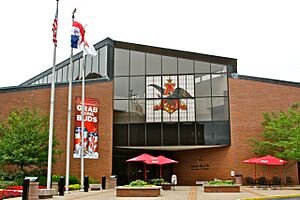
Anheuser-Busch Companies has operated 13 breweries, all located in the United States:
- St. Louis, Missouri (opened 1852)
- Newark, New Jersey (opened 1951)
- Los Angeles, California (opened 1954)
- Tampa, Florida (opened 1959, now closed)
- Houston, Texas (opened 1966)
- Columbus, Ohio (opened 1968)
- Jacksonville, Florida (opened 1969)
- Merrimack, New Hampshire (opened 1970)
- Williamsburg, Virginia (opened 1972)
- Fairfield, California (opened 1976)
- Baldwinsville, New York (opened 1983)
- Fort Collins, Colorado (opened 1988)
- Cartersville, Georgia (opened 1993)
The St. Louis brewery, which opened in 1852, is a National Historic Landmark District, and includes three buildings listed as National Historic Landmarks. Public tours of the brewery are offered. The tour takes visitors through the complex where they can see beer being made and packaged in a working part of the brewery. The company keeps a rotation of its famous Budweiser Clydesdales at its headquarters, and visitors to the brewery can observe the clydesdales in their exercise field and see their places in the carriage house.
The brewery was designated a National Historic Landmark in 1966. The landmarked area includes 189 structures spread over 142 acres (57 ha), including many red brick Romanesque ones "with square crenelated towers and elaborate details." The Brew House, built in 1891–1892, is particularly notable for its "multi-storied hop chandeliers, intricate iron-work, and utilization of natural light".
Other operations
Aside from supply operations like brewing and packaging, Anheuser-Busch Companies includes Anheuser-Busch Wholesale Operations Divisions (WOD), Anheuser-Busch Agricultural Operations, Anheuser-Busch Recycling Corporation, Eagle Packaging, and Busch Properties, which manages subsidiary-owned property. Anheuser Busch owns and operates aluminum can plants (Metal Container Corporation). MCC supplies Anheuser Busch breweries and Pepsi Beverages Group fillers across the US. Suppliers to Anheuser-Busch Companies include Owens-Illinois, which provides glass bottles to several Anheuser-Busch breweries. Anheuser-Busch also owns glass production facilities, such as the former Longhorn Glass, which provides glass for the Houston brewery. Anheuser-Busch Companies delivers its products to retailers through a network of more than 500 independent wholesalers and 13 wholly owned distributors.
On February 20, 1953, Anheuser-Busch purchased the St. Louis Cardinals major league baseball club and owned them until March 21, 1996, when the club was sold to a group of private investors.
In 1966, Busch Memorial Stadium was paid for and built by the brewery and opened for business; Anheuser-Busch later purchased the stadium in 1981 for $53 million and removed the "Memorial" in its name. The stadium was demolished in late 2005 and replaced by a new ballpark in 2006. Anheuser-Busch signed an agreement to retain the "Busch Stadium" name on the new building through 2025.
Up until 2009, Anheuser-Busch was also one of the largest theme park owners/operators in the United States, with ten parks throughout the country through its entertainment division, Busch Entertainment Corporation, including its three SeaWorld locations. The company is now known as SeaWorld Parks & Entertainment.
Beverage products
Anheuser-Busch Companies is responsible for the production, importation and distribution of several AB InBev products, including three company-designated global brands, Budweiser, Stella Artois, and Beck's. Other multi-country brands distributed or produced by Anheuser-Busch Companies include Leffe and Hoegaarden, while local brands produced by the company include Bass Pale Ale, Bud Light, Busch Beer, Landshark Lager, Michelob, Michelob Ultra, Natural Light, and Shock Top. The company also produces nonalcoholic beverages, malt liquors (such as King Cobra and Hurricane), and flavored malt beverages (e.g. the Bacardi Silver family and Tequiza).
On December 22, 2015, it was announced that Anheuser-Busch would purchase Breckenridge Brewery for an undisclosed sum.
Advertising
Prior to its acquisition by InBev, the company was known in the United States for its advertising presence, including a sports marketing division which created advertising material for the Super Bowl and many other sporting events. Budweiser has sponsored horse racing events and motorsports including NASCAR, the "Miss Budweiser" racing hydroplane, and the "Budweiser King" championship top fuel dragster of Kenny Bernstein.
Since the acquisition by AB InBev, the company has significantly cut back its advertising, predicated on the belief that "changing demographics and media habits no longer require spending as much on mainstream sports events".
Ties with Washington University in St. Louis
Adolphus Busch joined Washington University's Board of Directors in 1895, back when the school was still located on its old downtown St. Louis campus. Adolphus would continue to serve on the board until his death in 1913, at which point his son, August Busch Sr. took over his seat. Though Adolphus Busch III and Gussie Busch never sat on the board, the ties between their company and the school were still strong. August Busch III, CEO of Anheuser-Busch from 1975 to 2002, would become a trustee of the university, a position he holds to this day. The Anheuser-Busch Foundation donation that gave its name to Anheuser-Busch Hall was made in honor of Fred L. Kuhlmann, an executive officer of both the company and the St. Louis Cardinals under August Busch III. Kuhlmann, who held these positions for most of the 1980s and early 1990s, graduated from WashU's undergraduate and law programs. Though the Busch family no longer owns Anheuser-Busch, the connection between the company and the university is ongoing. Jack H. Purnell, former CEO of Anheuser-Busch, where he worked for 36 years, is an executive in residence of the Olin Business School.
See also
- Anheuser-Busch InBev
- Anheuser-Busch Brewing Association Building
- SeaWorld Entertainment
- Manufacturers Railway (St. Louis)
- Jacques Chirac – former President of France worked at the St Louis plant in the 1950s during his summer term at Harvard University.


